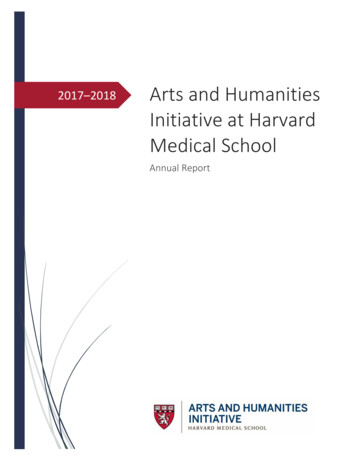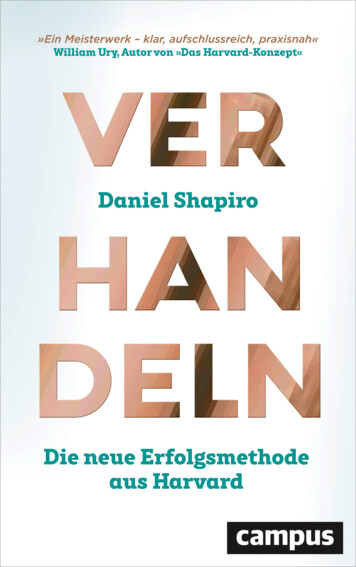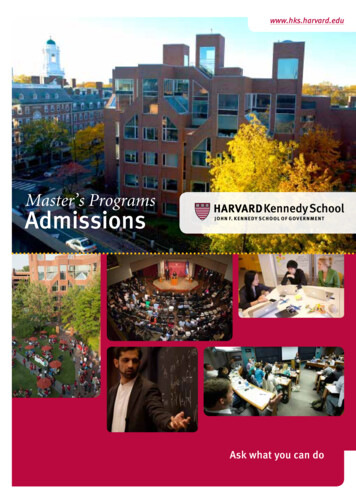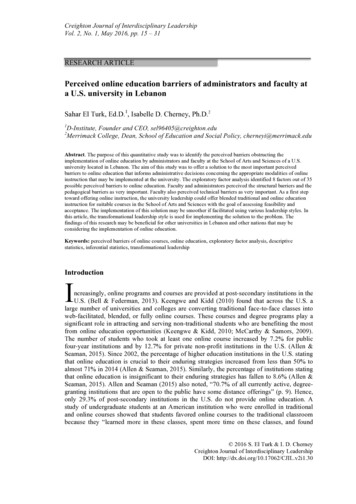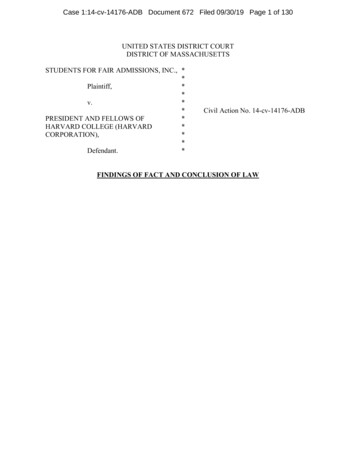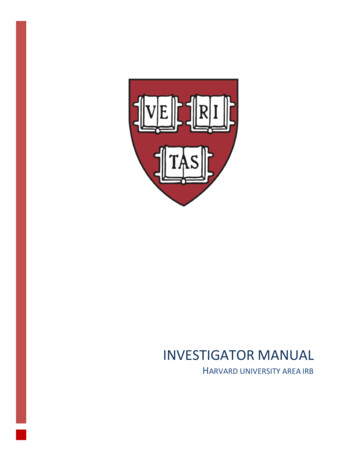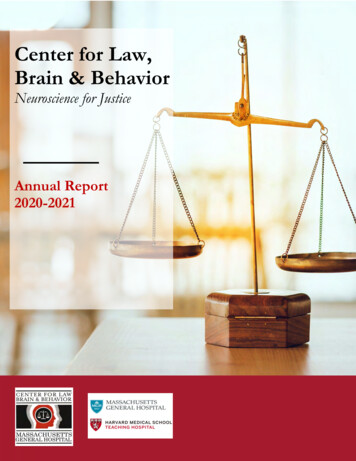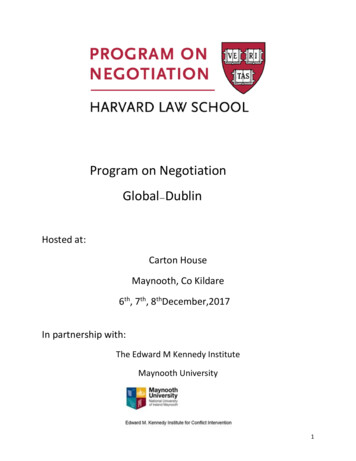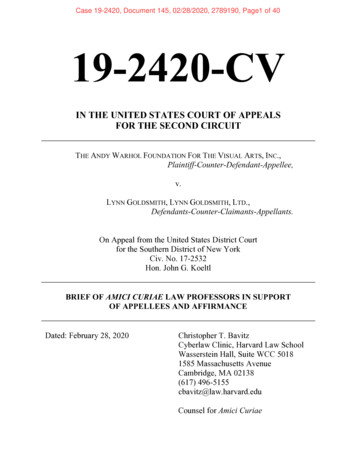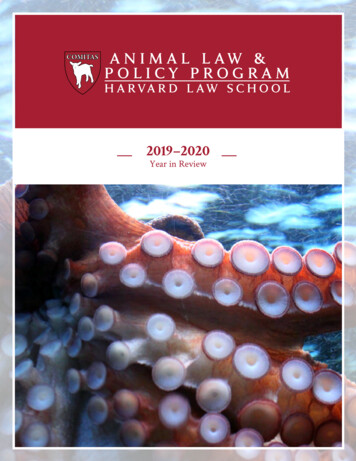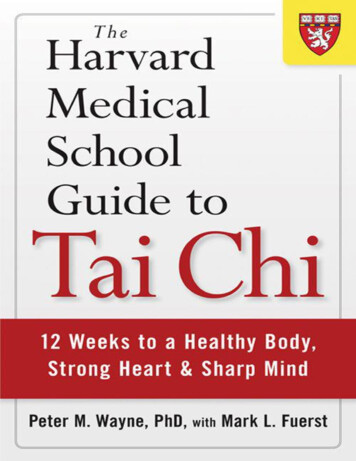
Transcription
“The Harvard Medical School Guide to Tai Chi is a significant milestone in the integration ofEastern and Western medicine. It deftly summarizes the scientific evidence for the healingpotential of this traditional Chinese system of body movement and gives readers practical advicefor using it in everyday life. I recommend it highly.”—Andrew Weil, MD, Professor of Medicine, University of Arizona, and author of 8 Steps toOptimum Health“Dr. Wayne gives us a magnificent and useful contribution for the betterment of our health andwell-being through the proper integration of Tai Chi into our lives.”—Herbert Benson, MD, author of The Relaxation Response and Professor of Medicine,Harvard Medical School“Peter Wayne is that rare individual who is sufficiently ‘bilingual’ to introduce Tai Chi to alargely open-minded yet skeptical medical community and to sensitively and movingly celebrateits timeless poetry, power, and appeal. This is a book for all to learn from and enjoy.”—David Eisenberg, MD, Harvard School of Public Health and the Samueli Institute, and FormerChief of the Division of Research and Education in Complementary and Integrative MedicalTherapies, Harvard Medical School“Evidence has shown that unhealthy lifestyle is the cause of most if not all chronic conditionssuch as diabetes, arthritis, and heart disease. Dr. Wayne’s book, with his expertise in medicalresearch and Tai Chi, is a significant step towards modernizing Tai Chi—essential to making TaiChi a central part of practical and effective solutions to the epidemic of chronic disease.”—Dr. Paul Lam, director of the Tai Chi for Health Institute and author of Teaching Tai ChiEffectively and Tai Chi for Beginners“Peter Wayne has long been a leader in scientific research into how Tai Chi boosts health andwell-being. In this brilliant book, he blends rigorous Western science with Eastern wisdom topresent an illuminating and thoroughly modern view of a wonderful, life-enhancing art. Irecommend it highly to anyone interested in Tai Chi, from novice to advanced practitioner.”—Yang Yang, PhD, director, Center for Taiji and Qigong Studies, and author of Taijiquan: TheArt of Nurturing, The Science of Power“Highly readable and deeply informative. . . . This book has the potential of once and for alldispelling any lingering myths that Tai Chi and Qigong, and Western science’s growingunderstanding of its uses, are anything less than a profound health revolution that can helpprevent or treat the majority of health challenges, and ultimately may save society hundreds ofbillions if not trillions in future annual health care costs. The Harvard Medical School Guide toTai Chi may well be that point we look back to and say, ‘That was the tipping point thatunleashed the building wave of Tai Chi, which has now transformed modern health care.’”—Bill Douglas, founder of World Tai Chi and Qigong Day and author of The Complete Idiot’sGuide to T’ai Chi and QiGong
ABOUT THE BOOKConventional medical science on the Chinese art of Tai Chi now shows what Tai Chi mastershave known for centuries: regular practice leads to more vigor and flexibility, better balance andmobility, and a sense of well-being. Cutting-edge research from Harvard Medical School alsosupports the long-standing claims that Tai Chi also has a beneficial impact on the health of theheart, bones, nerves and muscles, immune system, and the mind. This research providesfascinating insight into the underlying physiological mechanisms that explain how Tai Chiactually works.Dr. Peter M. Wayne, a longtime Tai Chi teacher and a researcher at Harvard Medical School,developed and tested protocols similar to the simplified program he includes in this book, whichis suited to people of all ages, and can be done in just a few minutes a day. This book includes:The basic program, illustrated by more than 50 photographsPractical tips for integrating Tai Chi into everyday activitiesAn introduction to the traditional principles of Tai ChiUp-to-date summaries of the research literature on the health benefits of Tai ChiHow Tai Chi can enhance work productivity, creativity, and sports performanceAnd much morePETER WAYNE, PhD, is Assistant Professor of Medicine at Harvard Medical School and theDirector of Research for the Osher Center for Integrative Medicine, jointly based at HarvardMedical School and Brigham and Women’s Hospital. Prior to this appointment, Dr. Wayneserved as the Director of Tai Chi and Mind-Body Research Programs at the Osher ResearchCenter and Founding Research Director at the New England School of Acupuncture. He hasmore than thirty-five years of training experience in Tai Chi and Qigong and is an internationallyrecognized teacher of these practices.
Sign up to learn more about our books and receive special offers from Shambhala Publications.Or visit us online to sign up at shambhala.com/eshambhala.
This book is dedicated to my parents and family, for their love, support, and encouragement all alongthe way and to all my teachers and mentors, East and West, for their wisdom, generosity, andinspiration.
Shambhala Publications, Inc.Horticultural Hall300 Massachusetts AvenueBoston, Massachusetts 02115www.shambhala.com 2013 by Harvard Health PublicationsCover design: Deborah HodgdonThe information in this book is not intended as a substitute for personalized medical advice. The reader should consult a physician beforebeginning this or any exercise program. The author and the publisher assume no responsibility for pain or injury experienced from thepractice of exercises presented here.All rights reserved. No part of this book may be reproduced in any form or by any means, electronic or mechanical, includingphotocopying, recording, or by any information storage and retrieval system, without permission in writing from the publisher.Library of Congress Cataloging-in-Publication DataWayne, Peter.The Harvard medical school guide to tai chi: 12 weeks to a healthy body, strong heart, and sharp mind / Peter Wayne, with Mark Fuerst.p. cm.Includes bibliographical references and index.eISBN 978-0-8348-2848-3ISBN 978-1-59030-942-1 (pbk.: alk. paper)1. Tai chi—Therapeutic use. 2. Health. I. Fuerst, Mark. II. Title.RM727.T34W39 2012613.7′148—dc232012025187
ContentsForewordAcknowledgmentsIntroduction: East Meets West at Harvard Medical SchoolPART ONETai Chi and Its Essential Elements1. The Ancient Promise of, and Modern Need for, Tai Chi2. The Eight Active Ingredients of Tai Chi3. Put the Principles into Practice: A Simplified Tai Chi ProgramPART TWOProof of the PromiseTai Chi through the Lens of Modern Science4. Improve Your Balance and Bones5. Ease Your Aches and Pains6. Strengthen Your Heart7. Deepen and Enrich Your Breathing8. Sharpen Your Mind9. Enhance Psychological Well-Being and Sleep QualityPART THREEIntegrating Tai Chi into Everyday Life10. Tai Chi for Two11. Cross-Train with Tai Chi12. On-the-Job Tai Chi13. Enhance Your Creativity with Tai Chi14. Lifelong Learning with Tai ChiAfterword: Tai Chi and Twenty-First-Century MedicineNotesIndexE-mail Sign-Up
ForewordHealth care has always undergone change. Old diseases disappear or are conquered; new ones taketheir place. New cures sometimes bring unexpected problems. Personal and societal expectations forhealth and longevity shift tremendously. Western patients now are asking for more prevention andhealth sustenance. Many want “soft-touch” in addition to hard technology. While many acute problemsseem to be under control, it seems that there are not enough solutions for living with or gracefullymanaging chronic illness. New discoveries and directions are continually being examined.Part of the quest for new answers is re-examining older approaches to illness. Have therapies thatcan provide answers to new problems withstood the test of time? Certainly, the popularity and recentscientific research into acupuncture and Ayurvedic medicine suggest that, in parallel withglobalization, there is a new opening to non-biomedical systems. I’ve had a ringside seat on thisemergent global perspective with my own work building links between Asian medicine and modernmedicine. Sorely missing has been a book that bridges the wisdom of Tai Chi with the scientificinsights of biomedicine. This exceptional book has finally been written, remarkably within the contextof a leading medical school; it provides the needed platform to link East and West.The Harvard Medical School Guide to Tai Chi is a wonderful, elegant book that embraces thetensions between science and art, modern research and traditional wisdom, movement and stillness,and effort and effortlessness. The authors have written a Tai Chi book that embodies the gracefulnessof Tai Chi. Ideas, insights, concepts, overviews, and details, based on, for example, neuroimaging ofthe brain and Lao Tzu, move and swirl around in an elegant, rhythmic mixture that feels like Tai Chi.They make the Tai Chi movement called “Waving Hands Like Clouds” into both a visualization and anintuition, as well as a precise, measurable movement with quantifiable physiological effects.This book connects ancient traditions that look to the past with fast-paced, cutting-edge science thatconstantly re-envisions a new future. It respects both wisdom and experience from the East andscience and experiments from the West. Separations become opportunities to see connections.Boundaries are seen just as convenient signposts to keep a conversation on a linear topic (for at leasta while).Peter Wayne himself is an embodiment of these tensions. His background—as a Harvardacademician and medical researcher originally trained as an evolutionary biologist, an esteemed andrevered Tai Chi teacher, and a down-home, no-nonsense Brooklyn guy with immigrant parents—haswritten an evidence-based book that captures the poetry of Tai Chi. This book is audacious. Ideasintersect, methodologies switch, and tensions nourish each other. Tai Chi is broken down intocomponent therapeutic parts, while science is used to demonstrate the intersection of mind and bodyand the importance of the imagination and ritual. The natural world seen through the lens of evolutionconnects with the cosmological notions of yin and yang. Nature and culture are separate and yet stillmerge. Just as the book knows no boundaries, you will be gently guided to new, unexpected places. Inthe end, you will have tasted and experienced the vastness of a poem with limitless implications.Inspiring ideas about meditative stillness are balanced with information from randomized controlledtrials. Both are enveloped by practical, nitty-gritty advice, such as how to find a good Tai Chi teacher.Peter has written a timely book that is accessible and relevant to many audiences. This booknourishes many needs. If you want to learn Tai Chi and integrate it into your personal life, you willfind this book to be an enticing adventure. If you are an experienced Tai Chi and mind-body
practitioner interested in understanding the relevant emergent science, you will find a supportiveguide. Physicians, allied health professionals, and alternative practitioners looking to advise theirpatients will find a fount of knowledge. Finally, health policy people with questions about Tai Chiwill find their answers.Chapter 1 is a clear, readable overview of Tai Chi’s history and current developments. The chaptergoes beyond the mythic (though it tells us some of the myths) and presents Tai Chi as a constantlyevolving practice that necessarily undergoes changes as it reaches the Western world and must engagescience and medical research.Chapter 2 introduces a particularly unique contribution of this book—the articulation of what Peterhas coined the “Eight Active Ingredients of Tai Chi.” With links to Tai Chi classics and modernscience, the chapter offers a clear explanation of the therapeutic components of Tai Chi. Thediscussion dissects Tai Chi into unexpected components, and yet somehow manages to recombinethem into an elegant whole. It allows you to test the territory and encourages you to make some newmovements.In Chapter 3, the eight active ingredients are integrated into a very practical Tai Chi trainingprogram, similar to programs employed in Peter’s clinical trials. Throughout this chapter, you canhear Peter’s calm, embracing teaching voice. You’re actually in his class.Chapters 4 through 9 present a very readable, exciting summary of medical and basic scienceresearch on Tai Chi. In a balanced, objective way, the research covers what is known about Tai Chi’simpact on health, ranging from fall prevention and cardiovascular risk factors to how it helps managechronic pain and depression. In some cases, Peter creatively reaches outside of Tai Chi research toshow potential and future directions. For example, Chapter 8, his discussion of clinical andphysiological studies of motor imagery research is beautifully linked with the traditional Chineseconcept of intention (yi). Here, the evidence is presented not so much to document what scienceknows so far, but rather to open doors for innovative discussion.In Chapters 10 through 14, Peter realigns and brings together all the previous discussions ofscience and situates them into practical activities of everyday life. Tai Chi now informs the socialinteractions you navigate at work and at home, as well as your creative endeavors, including in thearts and sports. Finally, he provides practical information about developing a regular Tai Chipractice, finding Tai Chi classes, and knowing what to look for in a good Tai Chi program.This book provides powerful insights and messages from multiple angles that somehow arepertinent to many different kinds of people. What is more amazing, Peter Wayne weaves thesedifferent perspectives into a single dance that is the essence of Tai Chi—an embrace of the flow andmovement of the cosmos itself.TED KAPTCHUKAssociate Professor of MedicineHarvard Medical SchoolAuthor, The Web That Has No Weaver:Understanding Chinese Medicine
AcknowledgmentsThis book would not be possible without the teachings, support, and feedback of so many people,more than I can possibly list here.The Osher Center for Integrative Medicine at the Harvard Medical School and Brigham andWomen’s Hospital has been an amazing incubating ground for many of this book’s ideas. I amindebted to my mentors and friends Julie Buring, Ted Kaptchuk, Sally Andrews, and David Eisenbergfor supporting my academic transition from evolutionary biology to integrative medicine research, fortheir vision, and for exemplifying and demanding the highest scientific standards; to my colleaguesand research collaborators, many of whom provided feedback on book sections or directlycontributed to the original research on which it is based, including Andrew Ahn, Gloria Yeh, PaoloBonato, Helene Langevin, Richard Hammerschlag, William Stason, Eric Jacobson, Cathy Kerr, BradManor, Ge Wu, Rebecca Wells, Suzie Bertisch, Ellen Connors, Mary Anne Ryan, Andrea Hrbek,Gurjeet Birdee, Donald Levy, Rosa Schnyer, Russell Phillips, Doug Kiel, Harriet Samuelson, AdiHaramati, Steven Wolf, Jeff Hausdorff, Lew Lipsitz, Vera Novak, C. K. Peng, Ary Goldberger, andWeidong Lu; and to my mentors and colleagues who shaped my thinking in evolutionary biology andecology, including William Drury, Craig Greene, John Connolly, Fahkri Bazzaz, Tim Sipe, DavidAckerly, Suzanne Morse, and David Folger.Much of the research this book draws from would not have been possible without the generoussupport of the Bernard Osher Foundation; federal grant support from the National Center forComplementary and Alternative Medicine at the National Institutes of Health; support from theKohlberg Family Foundation; and the personal vision and trust of two mentor-patrons, ElizabethMcCormack and Betsy Aron.Equally invaluable have been my many teachers of Tai Chi and related healing arts. I am gratefulfor their inspiring, unswerving commitments to their own journeys that generated the expertise andwisdom they so generously shared. I am especially indebted to my two root Tai Chi and internalmartial arts teachers, Robert Morningstar and Arthur Goodridge, for their remarkable insights into TaiChi and multitudes of related practices, and to their encouragement to think independently and sharethese practices with others; to Charles Genoud, whose teaching in Gesture of Awareness transformedmy understanding of Tai Chi; to Mantak Chia, Michael Winn, and Marie Favarito for their teachings inQigong and inner alchemy; to Calvin Chin for his patience in teaching me Kung Fu; and to CarolCaton, whose wisdom and teaching defy categorization. I am also thankful for my teachers in thehealing arts, many of whom have helped keep me healthy on my journey, including Xiaoming Cheng,Weidong Lu, Eric Jacobson, Randall Ferrell, Kuei Kuahara, Matthew Kowalski, Art Madore, andEdgar Miller.My Tai Chi and Qigong students, past and present, including all of our study volunteers, haveinspired me through their practice and commitment, kept me honest, and motivated me continuously toexplore and enrich my own practice, which makes it fun and easy to keep showing up to teach. I wishto acknowledge especially the camaraderie and friendship of my senior students. Many of them havehelped teach in our clinical trials and have contributed meaningfully to the material in this book; theyinclude Jane Moss, Stanwood Chang, Regina Gibbons, Chris Lavancher, Deborah Cake, Marty Heitz,Pam Cobb, and Chris Zarza.Most personally, I wish to thank my parents for their bravery, strength, and love, and my big sister
Debbie for her unswerving support. And, finally, I am grateful beyond words to Liz, my life partnerand best friend, and Sam, my son, the richest sources of joy I have known. Thanks to both of you fortolerating my often too busy life, and reminding me every day what it’s really all about.It has been great working with my coauthor, and now friend, Mark Fuerst. This book would neverhave happened without his deft writing skill, commitment to learning Tai Chi while writing this book,and remarkable patience, generosity, and optimism. We would also like to thank our Shambhalaeditor, Beth Frankl; the Chief Editor of Books at Harvard Health Publications, Julie Silver; and ouragent, Linda Konner; for sharing their wisdom of the publishing industry and for their total support ofthis book project. Thanks also to C. J. Allen for his excellent photographic skills, and to DanLitrownik for his assistance with footnotes.In addition, Mark Fuerst would like to acknowledge the love and support of his wife Margie, sonBen, and daughter Sarah during the time spent away from them while he was writing and editing; thecontinuing love of his mother, Peppy; the camaraderie, brainstorming, and encouragement of thewriters of the Brooklyn Brown Bag Lunch Group; and the wisdom, kindness, and patience of his twoTai Chi teachers, Phil Catapano and Rebecca Wolf.
IntroductionEast Meets West at Harvard Medical SchoolIn July 2009, along with six other Tai Chi and mind-body researchers representing leading USmedical schools, I found myself sitting on a panel with five of the most renowned living grandmasters of Tai Chi—the equivalents of Dalai Lamas of Tai Chi. This unprecedented meeting betweenTai Chi researchers and masters was part of the First International Tai Chi Symposium on the campusof Vanderbilt University Medical School, a landmark event for the world of Tai Chi. For the firsttime, masters representing all major Tai Chi styles convened in one place to teach and personallyshare their passion for Tai Chi, show unity across all styles, and speak with one voice about the futureof this ancient martial art. More than 500 Tai Chi enthusiasts, medical researchers, policy makers, andhealth-care lobbyists sat in the audience awaiting this historical event.For me, the fact that this evening’s symposium was devoted to exploring the role that Westernscientific research might play in informing Tai Chi’s development and integration into Western healthcare was even more remarkable. Working by day as a medical researcher objectively studying thescience of Tai Chi and at night as a community-based Tai Chi instructor, for many years I have walkedthe metaphorical S-shaped line dividing the more rational and intuitive halves of the Tai Chi yin andyang symbol. Both as a scientist and a teacher/practitioner, I have explored how best to bridge thewisdom underlying my two vocations, or in the lingo of Tai Chi, how the yin and yang can inform oneanother.In many ways, the symposium was very successful. Some rich exchanges between the masters andresearchers highlighted the promise of Tai Chi for improving health in our aging population; forexample, by preventing heart disease and fall-related fractures. Other exchanges centered on thepotential for cutting-edge scientific instrumentation to elucidate the impact of Tai Chi onphysiological processes in the brain, heart, and musculoskeletal system. A brief discussion suggestedhow modern technology might help understand better the traditional Chinese medicine conceptsforeign to most Westerners, such as Qi, or energy flow in the body.Yet, despite these unprecedented exchanges of ideas, toward the end of the evening, I found myselfa little dissatisfied and wanting much more. On a very simple level, I felt as if a few hours’ time wasfar too little to devote to such rich topics. However, even more fundamentally, I felt that the depth ofthe discussions was limited by the huge cultural, linguistic, and epistemological barriers between theTai Chi masters and the scientists. We do not yet have a well-developed language or framework tofacilitate the bridging between the practice and the science of Tai Chi. As I sat on stage at theinterface of two very different cultures—Eastern healing arts and Western science—I saw clearlyhow much work still was needed to build bridges. Part of my calling, and a central purpose of thisbook, is to explore this interface between the East and West through Tai Chi.The science of Tai Chi is just now catching up with and substantiating what Tai Chi practitioners haveknown for centuries—Tai Chi often leads to more vigor and energy, greater flexibility, balance andmobility, and an improved sense of well-being. Cutting-edge research now lends support to long-
standing claims that Tai Chi favorably impacts the health of the heart, bones, nerves and muscles,immune system, and the mind. This research also provides insight into the underlying physiologicalmechanisms that explain how Tai Chi works. This knowledge has enabled researchers like myHarvard Medical School colleagues and me to shape the essential elements of Tai Chi into programsthat are well suited for a modern Western lifestyle and to integrate Tai Chi training efficiently into therehabilitation and prevention of many health conditions.“YIN AND YANG—THE MOTHER OF TEN THOUSAND THINGS”As this quote from Lao Tzu suggests, Tai Chi derives its name from the concept of yin and yang ,also known as the Tai Chi symbol. Yin and yang is a central concept in traditional Chinese medicine,philosophy, and science, and it is one of the deepest pillars of Chinese culture. The yin-yang symbol,now a very popular symbol in the West as well, depicts two complementary polar opposites that,together, create a dynamic, balanced, integrated, and inter-dependent whole.Tai Chi training embodies this yin-yang concept at multiple levels. At the most obvious, physicallevel, Tai Chi is an exercise that aims to strengthen, stretch, balance, and coordinate and integrate theleft and right halves of the body, the upper and lower halves of the body, and the extremities of thebody with the inside or core. At a more subtle level, Tai Chi integrates body and mind. Bodymovements are coordinated with rhythmic, conscious breathing and multiple cognitive and emotionalcomponents—including focused attention, heightened self-awareness, visualization, imagery, andintention.At perhaps an even more subtle level, Tai Chi sensitizes and integrates you with your social andphysical environment. At an interpersonal level, being in tune with other people in your socialenvironment helps you to learn to read and appropriately respond to their cues. This internal/externalintegration is one of Tai Chi’s secrets as a martial art—by becoming extremely sensitive to youropponent’s moves, you learn to lead by neutralizing and following. Connecting with nature can alsobe an integral part of Tai Chi training. Practicing outside in a park may provide a sense of beingrecharged or nourished by the natural environment. For some, heightened conscious awareness ofoneself, and our connection to and integration with the greater natural world, can also afford aspiritual dimension—enhancing a sense of being part of some larger vital, unfolding natural process.To an outsider watching a master practice or perform Tai Chi, successful yin-yang integration isreflected in the seamless connection of graceful movements, with one flowing into another, as well asa sense of focus, calmness, and peacefulness. You can sense that the master has both inner and outerintegration and awareness, and is in tune with himself or herself and the surrounding environment. InTai Chi, as with yin and yang, everything is interconnected. The Tai Chi master reflects whatProfessor Ted Kaptchuk, my Harvard Medical School colleague and scholar on Chinese medicine,calls a “Web that has no Weaver.”1This Eastern holistic and ecological view of the body, mind, and health now is becomingincreasingly appreciated and adopted within the Western medical community. Elements of this holisticperspective have been implicit throughout the history of what we now call conventional medicine, orbiomedicine, but the modern Western medical community increasingly has relied on a reductionistframework for defining health, managing disease, and training physicians. The central tenet of thismodern reductionist model is to focus on root causes of disease, for example, infectious agents,genetic or developmental abnormalities, or injuries. The reductionist approach assumes that complex
problems can be solved by dividing them into smaller, simpler parts, or into more tractable units.Another Harvard Medical School colleague and collaborator, Dr. Andrew Ahn, has called thisstrategy “divide and conquer.”2Of course, reductionism in modern medicine has led to tremendous successes, including thedevelopment of medications, genetic markers, imaging, and curative surgery. However, reductionismhas its limits and downsides. As Ahn says, “Reductionism becomes less effective when the act ofdividing a problem into its parts leads to a loss of important information about the whole.”3This limitation inherent in dividing a problem is especially the case in complex chronic diseasessuch as diabetes, coronary artery disease, or recurrent low-back pain, where a single factor rarely isimplicated as being solely responsible for the disease development or presentation. Rather, multiplefactors are often identified, and the disease evolves through complex interactions between them. Inaddition to missing the forest for the trees, some other concerns of reductionism include the loss of thewhole person, depersonalization of medicine, lack of communication among specialists, and evengreater costs due to lack of coordinated care.HARVARD LOOKS TO THE EASTAt Harvard Medical School, as well as at many other academic medical centers across the UnitedStates, signs of holistic thinking are evident in medicine at all levels, from clinicians to researchers toeducators, including a vibrant program evaluating the medical benefits of Tai Chi and related mindbody practices. In 2000, the Harvard Medical School Council of Academic Deans established theDivision for Research and Education in Complementary and Integrative Medical Therapies. Theprogram was charged with facilitating interdisciplinary and inter-institutional faculty collaborationfor purposes of: (1) research evaluation of complementary and integrative medical therapies; (2)delivering educational programs to the medical community and the public; (3) and investigating thedesign of sustainable models of complementary and integrative care delivery in an academic setting.Since its inception, and now under the auspices of the Osher Center for Integrative Medicine jointlybased at Harvard Medical School and Brigham and Women’s Hospital, faculty and collaboratorshave received dozens of National Institutes of Health grants, published hundreds of peer-reviewedscientific papers, and are affecting significantly the care received across Harvard hospitals. Today,nearly all of the Harvard hospitals have programs that provide some form of integrative medicine. Atboth Brigham and Women’s Hospital’s Osher clinic and Massachusetts General Hospital’s BensonHenry clinic, physicians and complementary alternative medicine practitioners see patients, andprescriptions might include a course of Tai Chi, meditation, yoga, and counseling on diet and lifestyle,alongside conventional medicine. Harvard Medical School hospitals are examples of how insight andcredible research supporting the therapeutic promise of Tai Chi and related mind-body practices cancatalyze the integration of these practices into conventional medical practice.This book seeks to show, in a scientifically balanced and objective manner, the clinical promisefor Tai Chi and to provide insights into the underlying physiological processes that explain how TaiChi improves health. Tai Chi includes a rich mixture of therapeutic components—what I’ve organizedas the “Eight Active Ingredients.” Articulating knowledge of these ingredients has enabled myHarvard Medical School colleagues and me to sharpen the focus of Tai Chi for our modern Westernlives and target more efficiently rehabilitation and prevention for many health conditions. With
Tai Chi may well be that point we look back to and say, ‘That was the tipping point that unleashed the building wave of Tai Chi, which has now transformed modern health care.’” —Bill Douglas, founder of Worl
